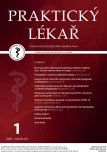Possibilities in rehabilitation of COVID-19 patients
Authors:
M. Grünerová Lippertová; J. Pětioký; S. Šilhavá; T. Gueye; M. Dědková; Z. Nerandžič; B. Bakalář
Authors‘ workplace:
Klinika rehabilitačního lékařství 3. LF UK a FNKV, Praha, Přednostka: prof. MUDr. Marcela Grünerová Lippertová, Ph. D.
1; Rehabilitační ústav Kladruby, Ředitel: Ing. Josef Hendrych, MBA
2; Klinika anesteziologie a resuscitace 3. LF UK a FNKV, Praha, Přednosta: doc. MUDr. František Duška, Ph. D.
3
Published in:
Prakt. Lék. 2021; 101(1): 27-31
Category:
Of different specialties
Overview
The basic goals of physiotherapy in critically ill patients with SARS-CoV-2 infection are to improve the patients’ clinical condition, shorten their stay in the intensive care unit and prevent long-term or permanent damage, with an early return to normal life. In the acute phase of the disease, we use passive and assistive techniques. After stabilization of cardiopulmonary functions, therapeutic spectrum can be expanded with targeted respiratory therapy, mobilization and individually tailored reconditioning training. Physiotherapy should continue in the home environment, using telerehabilitation and distance therapy technologies.
Keywords:
SARS-Cov-2 infection – post-Covid rehabilitation – critical illness – early mobilisation – respiratory physiotherapy – recondition – distance physiotherapy
Sources
1. Sardu C, Gambardella J, Morelli MB, et al. Hypertension, thrombosis, kidney failure, and diabetes: Is COVID-19 an endothelial disease? A comprehensive evaluation of clinical and basic evidence. J Clin Med 2020; 9(5): 1417.
2. Tang N, Bai H, Chen X, et al. Anticoagulant treatment is associated with decreased mortality in severe coronavirus disease 2019 patients with coagulopathy. J Thromb Haemost 2020; 18(5): 1094–1099.
3. Yang X, Yu Y, Xu J, et al. Clinical course and outcomes of critically ill patients with SARS-CoV-2 pneumonia in Wuhan, China: a single-centered, retrospective, observational study. Lancet Respir Med 2020; 8(5): 475–481.
4. Whittaker A, Anson M, Harky A. Neurological manifestations of COVID-19: A systematic review and current update. Acta Neurol Scand 2020; 142(1): 14–22.
5. Rogers JP, Chesney E, Oliver D, et al. Psychiatric and neuropsychiatric presentations associated with severe coronavirus infections: a systematic review and meta-analysis with comparison to the COVID-19 pandemic. The Lancet Psychiatry 2020; 7(7): 611–627.
6. Moriguchi T, Harii N, Goto J, et al. A first case of meningitis/encephalitis associated with SARS-Coronavirus-2. Int J Infect Dis 2020; 94: 55–58.
7. Alberti P, Beretta S, Piatti M, et al. Guillain-Barré syndrome related to COVID-19 infection. Neurol Neuroimmunol NeuroInflamm 2020; 7(4): e741.
8. Gutierrez-Ortiz C, Mendez A, Rodrigo-Rey S, et al. Miller Fisher Syndrome and polyneuritis cranialis in COVID-19. Neurology 2020; 95(5): e601–e605.
9. Driggin E, Madhavan MV, Bikdeli B, et al. Cardiovascular considerations for patients, health care workers, and health systems during the coronavirus disease 2019 (COVID-19) pandemic. J Am Coll Cardiol 2020; 75(18): 2352–2371.
10. Kollias A, Kyriakoulis KG, Dimakakos E, et al. Thromboembolic risk and anticoagulant therapy in COVID-19 patients: Emerging evidence and call for action. Br J Haematol 2020; 189(5): 846–847.
11. Moses R. COVID 19 and respiratory physiotherapy referral guideline, 2020 [online]. Dostupné z: https://www.acprc.org.uk/Data/Resource_Downloads/COVID19andRespira-toryPhysiotherapyReferralGuideline.pdf [cit. 2020-12-20].
12. World Health Organisation. Mask use in the context of COVID-19 [online]. Dostupné z: https://www.who.int/publications-detail/advice-on-the-use-of-masks-in-the-community-during-home-care-and-in-healthcare-settings-in-the-context-of-the-novel-coronavirus-(2019-ncov)-outbreak [cit. 2020-12-20].
13. Ouchi A, Sakuramoto H, Unoki T, et al. Effects of manual rib cage compressions on mucus clearance in mechanically ventilated pigs. Respir Care 2020; 65(8): 1135–1140.
14. Müller A, Schandl-Freimüller P, Weinhofer B, et al. Respiratorische Physiotherapie bei erwachsenen beatmeten Patienten mit Covid-19. Pneumologie & HNO. 2020 [online]. Dostupné z: https://www.universimed.com/at/article/pneumologie/respiratorische-physiotherapie-bei-erwachsenen-beatmeten-patienten-mit-covid-2164017 [cit. 2020-12-20].
15. Morris PE, Goad A, Thompson C, et al. Early intensive care unit mobility therapy in the treatment of acute respiratory failure. Crit Care Med 2008; 36(8): 2238–2243.
16. Bezbaruah P, Swaminathan N, D’Silva C, Kidyoor A. Effect of graded early mobilization versus routine physiotherapy on the length of intensive care unit stay in mechanically ventilated patients: a randomized controlled study. Intern J Health Allied Sci 2012; 1(3): 172–177.
17. Kasotakis G, Schmidt U, Perry D, et al. The surgical intensive care unit optimal mobility score predicts mortality and length of stay. Crit Care Med 2012; 40: 1122–1128.
18. Heshui S, Xiaoyu H, Nanchuan J, et al. Radiological findings from 81 patients with COVID-19 pneumonia in Wuhan, China: a descriptive study. Lancet Infect Dis 2020; 20(4): 425–434.
19. Puntmann VO, Carerj ML, Wieters I, et al. Outcomes of cardiovascular magnetic resonance imaging in patients recently recovered from coronavirus disease 2019 (COVID-19). JAMA Cardiol 2020; 5(11): 1265–1273.
20. Mahase E. Long covid could be four different syndromes, review suggests. BMJ 2020; 371: m3981.
21. National Institute for Health Research. Living with Covid19 2020 [online]. Dostupné z: https://evidence.nihr.ac.uk/themedreview/living-with-covid19/ [cit. 2020-12-20].
22. Baig AM. Chronic COVID Syndrome: Need for an appropriate medical terminology for Long‐COVID and COVID Long‐Haulers. J Med Virol 2020. doi:10.1002/jmv.26624
23. Sudre CH, Murray B, Varsavsky T, et al. Attributes and predictors of Long-COVID: analysis of COVID cases and their symptoms collected by the Covid Symptoms Study App [online]. Dostupné z: https://www.medrxiv.org/content/10.1101/2020.10.19.20214494v2 [cit. 2020-12-20].
24. Sarfo FS, Ulasavets U, Opare-Sem OK, Ovbiagele B. Tele-Rehabilitation after Stroke: an updated systematic review of the literature. J Stroke Cerebrovasc Dis 2018; 27(9): 2306–2318.
Labels
General practitioner for children and adolescents General practitioner for adultsArticle was published in
General Practitioner

2021 Issue 1
- Memantine Eases Daily Life for Patients and Caregivers
- Metamizole vs. Tramadol in Postoperative Analgesia
- Metamizole at a Glance and in Practice – Effective Non-Opioid Analgesic for All Ages
- Memantine in Dementia Therapy – Current Findings and Possible Future Applications
- What Effect Can Be Expected from Limosilactobacillus reuteri in Mucositis and Peri-Implantitis?
Most read in this issue
- Time in range – a new parameter for diabetes mellitus metabolic control
- V. Joint statement of professional societies on pharmacological treatment of obesity Obesity has become a worldwide
- Prediabetes in general practitioner’s clinical practice
- Possibilities in rehabilitation of COVID-19 patients
